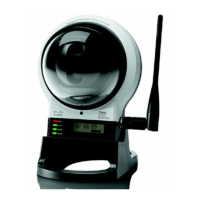
Do you have a question about the Cisco WVC200 - Wireless-G PTZ Internet Camera and is the answer not in the manual?
Details the minimum system specifications required for PC monitoring of the camera.
Explains the two operational modes for wireless local area networks: ad-hoc and infrastructure.
Describes compatibility with various Cisco wireless routers, access points, and network adapters.
Outlines common security risks, such as unauthorized access, and preventative measures.
Describes the antenna connector located on the side of the camera.
Details the components located on the front of the camera, including the microphone, LCD screen, and LEDs.
Explains the function and status indication of the camera's power, activity, Ethernet, and wireless LEDs.
Identifies the LAN port, input jacks, and the reset button on the bottom of the camera.
Provides recommendations for optimal camera placement and mounting for monitoring.
Illustrates a typical network setup using Cisco wireless products and the camera.
Step-by-step instructions for the initial camera configuration using a wired Ethernet connection.
Instructions on how to switch the camera between wired and wireless network modes.
Procedure for transitioning the camera from a wired to a wireless network connection.
Procedure for transitioning the camera from a wireless to a wired network connection.
Details how to connect external microphones and speakers to the camera for two-way audio.
Guides through setting camera name, description, time zone, date, and time.
Explains how to configure IP address, subnet mask, gateway, and DNS settings for the camera.
Steps to access the camera's configuration interface via a web browser using its IP address.
Overview of the main camera interface, displaying live video and control options.
Access point to various configuration settings for the camera, including device and network parameters.
Covers device, network, and wireless settings for initial camera configuration.
Explains advanced network protocols like RTSP/RTP, HTTP, Discovery Settings, and QoS.
Manages user authentication, administrator credentials, and defines user lists with access rights.
Provides options for restoring factory defaults, restarting the camera, and firmware upgrades.
Configuration for video resolution, quality, frame rate, and audio settings including compression.
Setup for configuring primary and secondary SMTP servers for sending email alerts.
Configuration options for uploading files to primary and secondary FTP servers.
Settings for recording and uploading files directly to a Network Attached Storage (NAS) device.
Guides on setting up motion detection, defining areas, sensitivity, and configuring alerts.
Configuration for Dynamic DNS service to enable remote access to the camera via a domain name.
Controls camera movement, setting preset positions, and configuring rotation sequences.
Displays system, image, network, and wireless status information of the camera.
Steps to set up the camera for continuous video recording via the Home window.
How to set specific camera positions for automated surveillance patrols.
Instructions for activating and configuring the camera's automated patrol sequence.
Setting up the camera to send email notifications upon detected events like motion.
Detailed steps to configure motion detection sensitivity, areas, and email alerts.
Guides on setting up port forwarding on a router to allow external access to the camera.
Recommended security measures for the camera and its wireless network connection.
Addresses common operational issues, connectivity problems, and video quality concerns.
Lists the technical specifications and features of the Cisco WVC210 camera.
Provides links to Cisco's online support, documentation, and product information pages.